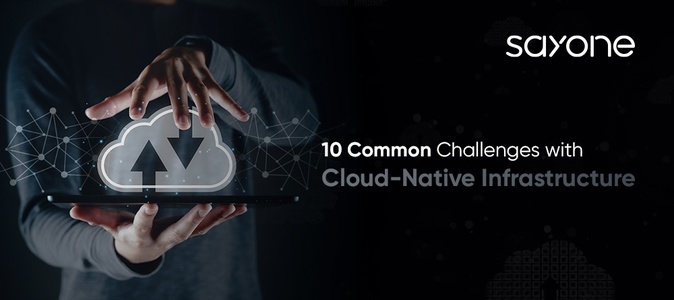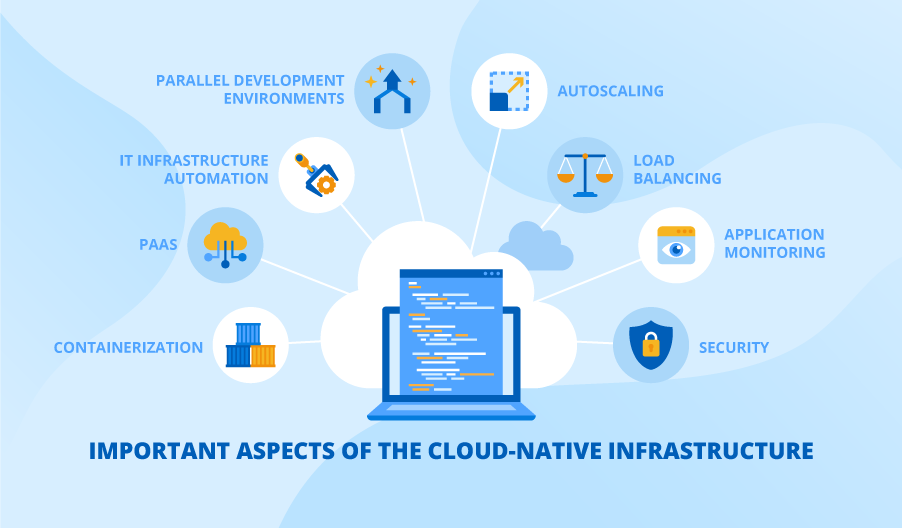10 Tips for Overcoming Cloud-Native Infrastructure Challenges

Share This Article
Table of Contents
Subscribe to Our Blog
We're committed to your privacy. SayOne uses the information you provide to us to contact you about our relevant content, products, and services. check out our privacy policy.
Clouds provide immense business value because of their operational model. By transforming monolithic applications into independently connected containers, developers can scale applications seamlessly as per demand. The cloud-native infrastructure allows you to write and deploy code anywhere, into several public, private, and hybrid cloud environments.
What is Cloud-Native Infrastructure
Cloud-native is fast becoming the standard for modern IT, with many organizations creating and running large-scale cloud-native applications in the production phase.
Cloud-native infrastructure refers to the ability to turn resources into commodities that can be automated, scaled, and manipulated according to demand.
Cloud-Native Infrastructure has the following common features:
- They are driven by APIs and easy to automate
- Hardware functions are hidden by abstractions
- High availability and failover and autoscaling are built-in
- Supports continuous deployment and CI/CD cycles
- Supports infrastructure as code (IaC) patterns
Common Cloud-Native Infrastructure Challenges
Moving to cloud-native infrastructure can bring about new challenges along with agility that was not available before. In this blog post, we attempt to list the top 10 cloud-native infrastructure challenges and how to overcome them.
1: Identity the Right Tools/Platforms
When shifting to cloud-native infrastructure, the first challenge is to identify the right tools or platforms that will work best for you.
Some suggestions are listed so that you can pick the right ones.
Read our blog titled “Build Cloud-Native Applications with Microservices Architecture.
Understand your company’s requirements such as:
- What is your organization trying to achieve?
- What are your goals?
- What tools do you need for this?
The Factors to Check Out when Choosing a Tool or Platform:
- Ease of use
- Cost
- Support
- Features
Select an all-inclusive tool offering cloud observability services so that you can effectively manage and monitor your infrastructure.
2: Select only Important Metrics
Cloud-native infrastructure generates numerous metrics many of which may not be important to you. You should only store and focus on data that matters. Otherwise, you will pay a high cost to store unnecessary data. Metrics are essential to understand your system’s health and detect performance issues.
3. Monitoring Microservices
Microservices are difficult to monitor because of the huge amount of data they produce.
One microservice may run on 100 different machines, and 100 microservices may be run on one device. Therefore, you have to track multiple metrics per service. You need a system to automatically track performance and flag performance issues. Manual monitoring is not feasible. Middleware can help to monitor the microservices in action and identify and fix any issues that come up.
Do you have a microservices application idea? Contact our business analysts today!
4: Costs
Confusing pricing models can be a challenge when establishing cloud-native infrastructure. Maintaining this infrastructure can also be expensive, especially for SMBs.
Many cloud providers offer different services, but each comes with a cost and may add up. Also, you have to be on the lookout for hidden costs.
5: Security, Compliance
Security and compliance are major challenges for cloud-native infrastructure. With new security protocols being added now and then, companies have to make sure that the infrastructure they have set up complies with these latest standards. Setting up an observability platform can help to keep your system secure.
Download our eBook for FREE: “Global Software Development Rates – an Overview”.
6: Reliability
Reliability issues can come from many different elements in the cloud-native infrastructure. Pinpointing the cause of bugs, errors, outages, latency spikes, etc., are difficult.
The use of a unified platform that can aggregate data across different sources and services can help you to quickly pinpoint problems and take preventive measures.
7: Lack of Visibility
The cloud being a distributed environment, it is difficult to gain visibility across very different systems when using traditional monitoring tools. It is best to use cloud observability services in such cases using which you can proactively fix the issues.
8: Keeping up to date with Outdated Technologies
It is difficult for cloud users to keep themselves updated with outdated technologies. Therefore, it is best to understand the technology that you are currently using and its current capabilities.
9: Absence of Technical Expertise
Lack of adequate technical expertise is another major challenge for users of the cloud-native infrastructure. You have to induct people with the appropriate skill set and experience in modern application architectures and cloud platforms. The workforce has to be qualified and certified to manage their cloud-native applications.
10: Need for Organizational Shifts and Team Shifts
It is vital to restructure your organization for cloud-native infrastructure. Organizational changes are imperative when moving to the cloud. It is Understanding how existing roles will transform in a cloud-native environment is also important for, team members to acquire new skills and understand the different tools of the cloud-native environment.
Conclusion
In light of the above challenges, any organization that wants to shift into cloud-native should do so with an experienced and supportive partner.
Looking for web or mobile app development services? Get in touch for a free consultation
Share This Article
FAQs
Setting up cloud-native infrastructure provides organizations with greater agility, portability, and resilience across different cloud environments.
Some of the common components of cloud-native infrastructure include containers, container orchestration technologies, serverless technologies, computer instances, infrastructure as code (IaC), auto-scaling, etc., among others.
Cloud-native infrastructure is a primary requirement to run cloud-native applications effectively. By infrastructure, we mean all the software and hardware that support the applications including data centers, deployment pipelines, operating systems, configuration management, and any other system/software required to support the life cycle of the applications.
Subscribe to Our Blog
We're committed to your privacy. SayOne uses the information you provide to us to contact you about our relevant content, products, and services. check out our privacy policy.


